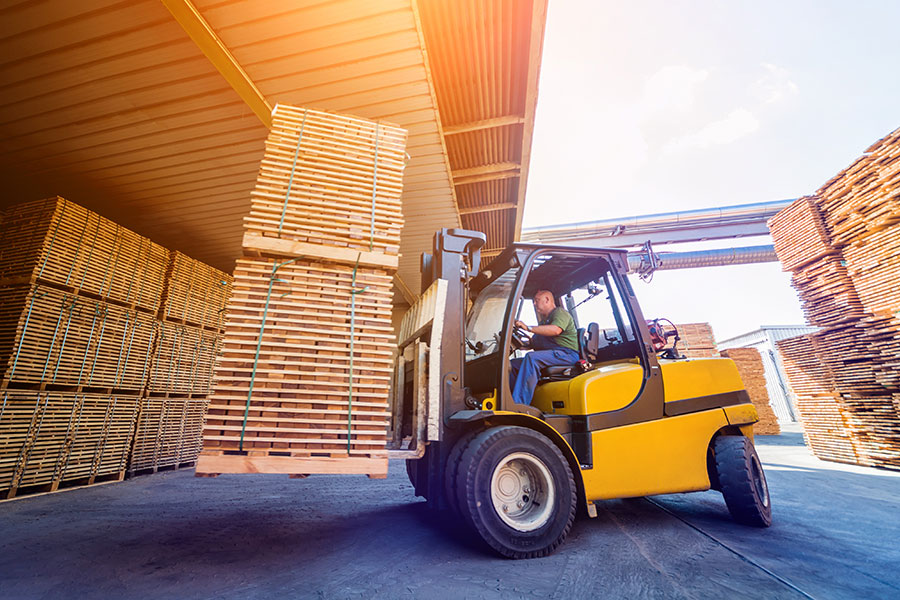Forklifts are the workhorse of any warehouse, but even these impressive machines have their limits. Let’s dive into forklift capacity so you’ll always feel confident knowing how much weight can a forklift lift.
Picture a massive beast roaming across the land. It is wider than two SUVs, weighs nearly 100 tons, is longer than a stretch limousine and can lift up to 72 tons. While it may seem like we’re describing something out of the “Jurassic Park” franchise, it’s actually something you can glimpse in person: the Finnish forklift Kalmar DCG720-10LB, holder of the Guinness Book of World Records title of “Strongest Forklift.”
Of course, the tines of most forklifts would snap off trying to lift half as much weight as the Kalmar DCG720-10LB. So, how do you know the capacity of your forklift? Let’s take a look.
Forklift weight capacity
To fully understand fork lift specs, it helps first to know how a forklift works.
A forklift is a sophisticated version of one of humankind’s oldest tools: the lever. A basic lever consists of a beam and a fulcrum, which is the beam’s pivot point. When a load is set on one end of a lever, pressure applied to the other end travels the length of the beam to raise the load. The location of the fulcrum determines how much pressure (or effort) is necessary and how high the load travels. For instance, when the fulcrum is close to the load, less effort is needed, but it only moves a short distance. A fulcrum far from the load requires more effort, but the load rises higher.
A forklift’s fulcrum is its front axle. Most forklifts used in a warehouse are “counterbalanced,” meaning the heavy battery that powers the truck and other weights are located in the rear of the vehicle. Most forklifts weigh twice as much as the forklift weight capacity. This forklift weight helps keep the truck level while lifting and moving heavy loads.
All forklifts have a data plate that lists its maximum carrying capacity. However, just because a forklift can lift a specific amount of weight, doesn’t always mean it should. That is determined by the load’s center of gravity, aka the load center.
Which dimension defines the load center?
OSHA defines the load center as “the distance from the face of the forks to the load’s center of gravity.” For a square container that’s centered on a forklift’s tines, the load center is the middle of a shipment. However, for a rectangular or irregularly shaped container, the weight may not be directly in the center.
To better understand forklift load center, picture two children playing on a seesaw. One weighs 50 pounds, and the other weighs 100 pounds. Usually, the bigger child controls the seesaw. However, if the 50-pound child sways side to side or leans back, they gain leverage by shifting their center of gravity and throwing the balance off.
Now, imagine a rectangular object measuring 48 inches by 60 inches and weighing 4,000 pounds. Placing this forklift load vertically on the tines (48 inches across) means the load center is 24 inches and safe to transport. However, loading the object horizontally (60 inches across) moves the load center to 30 inches, which may push the forklift load center too far forward and create a dangerous situation.
The stability triangle
The other calculation that impacts how much can a forklift lift is the stability triangle. The stability triangle is a theoretical area between a forklift’s two front tires (the fulcrum) and the middle of the rear axle. For a forklift to remain balanced, the center of gravity must stay within the stability triangle.
A forklift’s center of gravity is in the middle of the stability triangle when it is not carrying a load. However, the action of the tines lifting an object create what’s known as a combined center of gravity. The combined center of gravity is variable and changes as the object rises, the truck moves, the object shifts, etc. The truck will remain stable as long as the combined center of gravity stays within the boundaries of the stability triangle. If the combined center of gravity passes outside the stability triangle, the forklift is at risk of tipping over or another dangerous accident.
Forklift weight capacity
Forklift weight capacity is typically based on the standard size of most pallets, which is 48 inches by 48 inches. However, carrying capacity also assumes ideal conditions, such as a perfectly centered load and driving with the tines low. If these conditions are not met, the data is no longer 100% correct. Fortunately, it is possible to determine an adjusted forklift capacity.
It is common for a forklift to have a weight capacity of 4,000 pounds and a load center of 24 inches. However, if the driver must transport a pallet with the truck’s tines lifted a foot off the ground, the center of gravity—and the load center—shifts by 12 inches.
To calculate the new carrying capacity, start by determining the new load center. Do this by adding the original forklift load center with the height of the tines. Next, divide the forklift’s listed load center by the new load center you just calculated. Finally, multiply this result by the listed forklift weight capacity.
24 + 12 = 36 (This is the new load center.)
24/36 = 0.6667 inches
4,000 X 0.6667 = 2,666.8 pounds
By simply lifting the tines a foot off the ground, the forklift can no longer safely carry 4,000 pounds. The new weight limit is about 2,667 pounds, a significant difference. At Texas Motive Solutions, forklift safety is critical to us. So, if you have additional questions about how much can a forklift lift, please reach out to us. When it comes to forklift issues—especially forklift batteries—we’re your forklift repair experts. Please call us at (888) 316-2459 or fill out a form to learn about our services and discover everything we can do for you.



